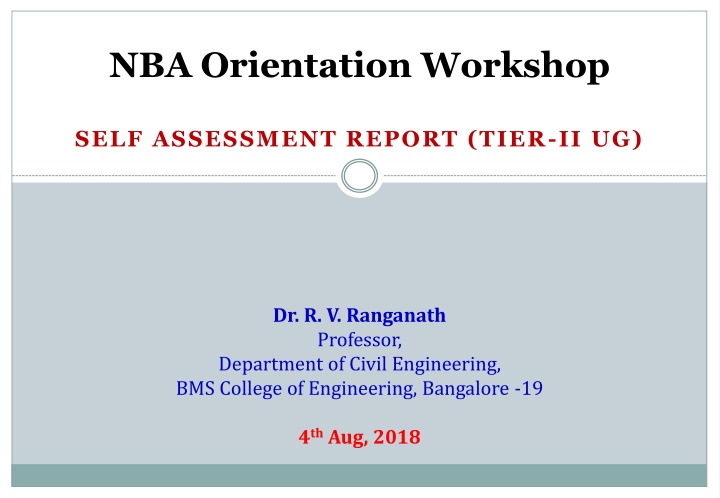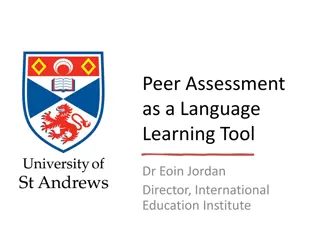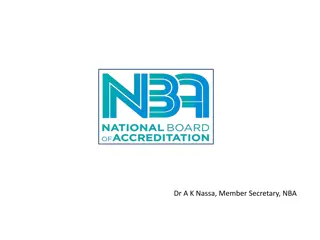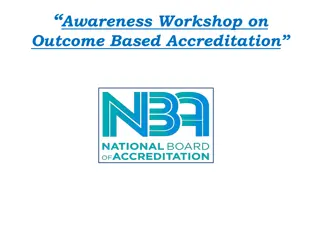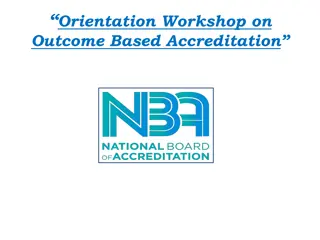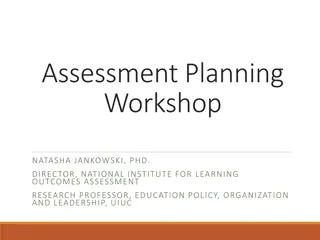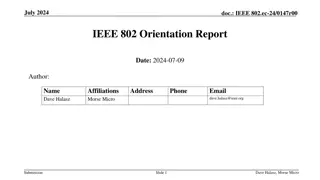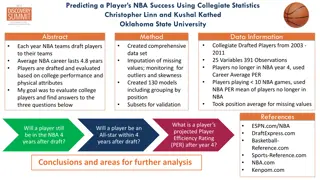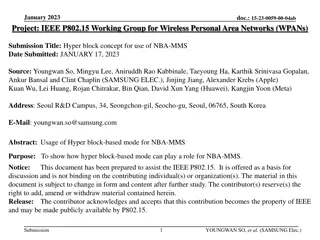NBA Orientation Workshop Self-Assessment Report Criteria Summary
This report provides a detailed analysis of the criteria related to vision, mission, program educational objectives, curriculum, teaching processes, student performance, faculty information, facilities, continuous improvement, and more. It evaluates the institutional information, program level, and institute-level criteria to ensure alignment with set standards.
Download Presentation

Please find below an Image/Link to download the presentation.
The content on the website is provided AS IS for your information and personal use only. It may not be sold, licensed, or shared on other websites without obtaining consent from the author.If you encounter any issues during the download, it is possible that the publisher has removed the file from their server.
You are allowed to download the files provided on this website for personal or commercial use, subject to the condition that they are used lawfully. All files are the property of their respective owners.
The content on the website is provided AS IS for your information and personal use only. It may not be sold, licensed, or shared on other websites without obtaining consent from the author.
E N D
Presentation Transcript
NBA Orientation Workshop SELF ASSESSMENT REPORT (TIER-II UG) Dr. R. V. Ranganath Professor, Department of Civil Engineering, BMS College of Engineering, Bangalore -19 4th Aug, 2018
SAR Contents PART A PART B Criteria No. 1 2 3 4 5 6 7 Institutional Information Criteria Summary Program Level Criteria Vision, Mission and Program Educational Objectives Program Curriculum and Teaching-Learning Processes Course Outcomes and Program Outcomes Students Performance Faculty Information and Contributions Facilities and Technical Support Continuous Improvement
Contd. Criteria No. 8 9 Institute Level Criteria First Year Academics Student Support Systems Governance, Resources Declaration by the Institution Program Outcomes (POs) & Program Specific Outcomes (PSOs) Institutional Support and Financial 10 PART C Annexure-I
CRITERION-1: Vision, Mission and Program Educational Objectives (PEOs) 1.1. State the Vision and Mission of the Department and Institute. Vision statement typically indicates aspirations and Mission statement states the broad approach to achieve aspirations Should be written in a simple language, easy to communicate and should define objectives which are out of reach in the present context Department Vision and Mission statements shall be consistent with the Example Institute Vision and Mission statements Example
Contd. 1.2. State the Program Educational Objectives (PEOs). Define the PEOs under the following broad categories: Preparation :Employment/Higher studies i. ii. Core competence : Discipline knowledge iii. Professionalism : Professional value - knowledge development Example iv. Life long learning : Environment Example
Contd. 1.3. Indicate where the Vision, Mission and PEOs are published and disseminated among stakeholders(PEOs). Availability on Institute website under relevant program link Availability at department notice boards HoD Chamber Department website, if available Availability in department level documents Documentary evidence 1.4. State the process for defining the Vision and Mission of the Department and PEOs of the program. Process to ensure: Effective participation of Stakeholders Effective Process implementation Documentary evidence Steps Steps
Contd. 1.5. Establish consistency of PEOs with Mission of the Department Generate a Mission of the Department PEOs matrix with justification and rationale of the mapping: PEO Statements PEO 1 PEO 2 PEO 3 PEO 4 M1 M2 Mn Note: M1, M2, . . Mn are distinct elements of Mission statement. Enter correlation levels 1, 2 or 3 as defined below: 1: Slight (Low) 2: Moderate (Medium) 3: Substantial (High) If there is no correlation, put -
CRITERION-2: Program Curriculum and Teaching Learning Processes (TLP) 2.1. Program Curriculum. 2.1.1. State the process used to identify extent of compliance of the University curriculum for attaining the Program Outcomes and Program Specific Outcomes as mentioned in Annexure-I. Also mention the identified curricular gaps, if any State the process details Mention identified curricular gaps Extent of compliance
Contd. 2.1.2. State the delivery details of the content beyond the syllabus for the attainment of POs & PSOs. Details of the following for the attainment of POs & PSOs Additional course Learning material Content Laboratory experiments Projects etc. Institute to provide inputs to the Affiliating University regarding curricular gaps and possible addition of new content/add-on courses in the curriculum to better attain program outcome(s)
Contd. 2.2. Teaching-Learning Processes. 2.2.1. Describe Processes followed to improve quality of Teaching and Learning Processes may include adherence to academic calendar and implementation of pedagogical initiatives such as - Real life examples Collaborative learning Quality of laboratory experience with regard to conducting experiments Recording observations Analysis of data etc. Encouraging bright students Assisting weak students etc. ICT supported learning Interactive classrooms
Contd. 2.2.2. Quality of internal semester Question papers, Assignments and Evaluation. Mention the initiatives, Implementation details and analysis of learning levels related to a. Quality of Semester Question papers b. Assignments c. Evaluation d. Relevance to COs
Contd. 2.2.3. Quality of Student Projects Consideration to factors including, but not limited to Environment & Safety Ethics Cost Type (application, product, research, review etc.) Standards Processes related to project identification, allotment, continuous monitoring and evaluation Demonstration of working prototype and enhancing the relevance of projects. Mention Implementation details including details of POs and PSOs addressed with justification
Contd. 2.2.4. Initiatives related to industry interaction Industry supported laboratories. Industry involvement in the program design and partial delivery of any regular courses for students. Impact analysis of industry institute interaction and actions taken thereof 2.2.5. Initiatives related to industry internship/summer training Industrial training/tours for students. Industrial / internship / summer training of more than two weeks and post training Assessment. Impact analysis of industrial training. Student feedback on initiatives
CRITERION 3: Course Outcomes and Program Outcomes 3.1. Establish the correlation between the Courses and the Program Outcomes (POs) and Program Specific Outcomes (PSOs) 3.1.1. Course Outcomes (COs) SARshould include course outcomes of One course/Semester (3rd to 8th) of study, Example however, should be prepared for all courses and made available as evidence Example 3.1.2. CO-PO matrices of courses selected in 3.1.1 (six matrices to be mentioned; one per semester from 3rd to 8th semester) COURSE COs PO1 PO2 PO3 PO4 PO5 PO6 PO7 PO8 PO9 PO10 PO11 CO1 3 3 - - - - - 1 - - - Design of RCC Structures 10CV5DCRCC CO2 3 3 3 - - - - 2 - - - CO3 3 3 3 - - - - 3 - - -
Contd. Note: Enter correlation levels 1, 2 or 3 as defined below: 1: Slight (Low) 2: Moderate (Medium) 3: Substantial (High) 3.1.3. Program level Course-PO matrix of all courses INCLUDING first year courses It may be noted that contents of Table 3.1.2 must be consistent with information available in Table 3.1.3 for all the courses.
Contd. 3.2. Attainment of Course Outcomes 3.2.1. Describe the assessment processes used to gather the data upon which the evaluation of Course Outcome is based Examples of data collection processes may include, but are not limited to- - Specific exam/tutorial questions - Assignments - Laboratory tests - Project evaluation - Student portfolios A portfolio is a collection of artifacts that demonstrate skills, personal characteristics, and accomplishments created by the student during study period, internally developed assessment exams, project presentations, oral exams etc.
Contd. 3.2.2. Record the attainment of Course Outcomes of all courses with respect to set attainment levels Program shall have set Course Outcome attainment levels for all courses The attainment levels shall be set considering average performance levels in the University Examination or any higher value set as target for the assessment years Attainment level Student performance in internal assessments with respect the Course Outcomes Performance in the University Examination
Contd. Measuring Course Outcomes attained through University Examinations Example related to attainment levels Vs. targets: (The examples indicated are for reference only. Program may appropriately define levels) Attainment Level 1: 60% students scoring more than University average percentage marks or set attainment level in the final examination Attainment Level 2: 70% students scoring more than University average percentage marks or set attainment level in the final examination Attainment Level 3: 80% students scoring more than University average percentage marks or set attainment level in the final examination
Contd. Attainment is measured in terms of actual percentage of students getting set percentage of marks If targets are achieved then all the course outcomes are attained for that year Program is expected to set higher targets for the following years as a part of continuous improvement If targets are not achieved the program should put in place an action plan to attain the target in subsequent years Measuring CO attainment through Internal Assessments: Target may be stated in terms of percentage of students getting more than class average marks or set by the program in each of the associated COs in the assessment instruments (midterm tests, assignments, mini projects, reports and presentations etc. as mapped with the COs
Contd. Examples related to attainment levels Vs. targets: Attainment Level 1: 60%students scoring more than 60% marks out of the relevant maximum marks Attainment Level 2: 70% students scoring more than 60% marks out of the relevant maximum marks Attainment Level 3: 80%students scoring more than 60% marks out of the relevant maximum marks Attainment is measured in terms of actual percentage of students getting set percentage of marks If targets are achieved then the PY1ICPHY and CV3DCMOF are attained for that year. Program is expected to set higher targets for the following years as a part of continuous improvement If targets are not achieved the program should put in place an action plan to attain the target in subsequent years Similar targets and achievement are to be stated for the other midterm tests/internal assessment instruments
Contd. Course Outcome Attainment: For example: Attainment through University Examination: Substantial i.e. 3 Attainment through Internal Assessment: Moderate i.e. 2 Assuming 80% weightage to University examination and 20% weightage to Internal assessment, the attainment calculations will be (80% of University level) + (20% of Internal level ) i.e. 80% of 3 + 20% of 2 = 2.4 + 0.4 = 2.8 Note: Weightage of 80% to University exams is only an example. Programs may decide weightages appropriately for University exams and internal assessment with due justification 50% - 50% Weightage = 1.5+1=2.5
Contd. Program may decide five attainment levels instead of three For ex.- Attainment levels: Level 5 Very High - Score from >2.5 to 3 Level 4 High - Score from >2 to 2.5 Level 3 Medium - Score from >1.5 to 2 Level 2 Low - Score from >1 to 1.5 Level 1 Very Low- Score from 0.5 to <1
3.3. Attainment of Program Outcomes and Program Specific Outcomes 3.3.1. Describe assessment tools and processes used for measuring the attainment of each of the Program Outcomes and Program Specific Outcomes Describe the assessment tools and processes used to gather the data upon which the evaluation of each of the Program Outcomes and Program Specific Outcomes is based indicating the frequency with which these processes are carried out Describe the assessment processes that demonstrate the degree to which the Program Outcomes and Program Specific Outcomes are attained and document the attainment levels
Contd. 3.3.2. Provide results of evaluation of each PO & PSO Program shall set Program Outcome attainment levels for all POs and PSOs The attainment levels by direct (student performance) and indirect (surveys) are to be presented through Program level Course-PO & PSO matrix as indicated PO Attainment: Similar table is to be prepared for PSOs Direct attainment level of a PO & PSO is determined by taking average across all courses addressing that PO and/or PSO. Indirect attainment level of PO & PSO is determined based on the student exit surveys, employer surveys, co-curricular activities, extra-curricular activities etc.
CRITERION 4: Students Performance Item CAY CAYm1 CAYm2 Sanctioned intake of the program (N) Total number of students admitted in first year minus number of students migrated to other programs/institutions plus no. of students migrated to this program (N1) Number of students admitted in 2nd year in the same batch via lateral entry (N2) Separate division students, if applicable (N3) Total number of students admitted in the Program (N1 + N2 + N3)
Contd. Number of students who have successfully graduated without backlogs in any semester / year of study (Without Backlog means no compartment or failures in any semester/year of study) I Year II Year N1 + N2 + N3 (As defined above) Year of entry III Year IV Year CAY CAYm1 CAYm2 CAYm3 (LYG) CAYm4 (LYGm1) CAYm5 (LYGm2)
Contd. 4.1. Enrolment Ratio (20) Enrolment Ratio= N1/N Item Marks (Students enrolled at the First Year Level on average basis during the period of assessment) >= 90% students >= 80% students >= 70% students >= 60% students Otherwise 20 18 16 14 0
Contd. 4.2. Success Rate in the stipulated period of the program 4.2.1. Success rate without backlogs in any semester/year of study Enrolment Ratio SI = (Number of students who have graduated from the program without backlog)/ (Number of students admitted in the first year of that batch and admitted in 2nd year via lateral entry and separate division, if applicable) Average SI = Mean of Success Index (SI) for past three batches Success rate without backlogs in any year of study = 25 Average SI
Contd. 4.2.2. Success rate in stipulated Period SI = (Number of students who graduated from the program in the stipulated period of course duration)/ (Number of students admitted in the first year of that batch and admitted in 2nd year via lateral entry and separate division, if applicable) Average SI = mean of Success Index (SI) for past three batches Success rate = 15 Average SI. Note: If 100% students clear without any backlog then also total marks scored will be 40 as both 4.2.1 & 4.2.2 will be applicable simultaneously
Contd. 4.3. Academic Performance in Third Year Academic Performance = 1.5 * Average API (Academic Performance Index) API = ((Mean of 3rd Year Grade Point Average of all successful Students on a 10 point scale) or (Mean of the percentage of marks of all successful students in Third Year/10)) x (number of successful students/number of students appeared in the examination) 4.4. Academic Performance in Second Year Academic Performance Level = 1.5 * Average API (Academic Performance Index) API = ((Mean of 2nd Year Grade Point Average of all successful Students on a 10 point scale) or (Mean of the percentage of marks of all successful students in Second Year/10)) x (number of successful students/number of students appeared in the examination)
Contd. 4.5. Placement, Higher Studies and Entrepreneurship Assessment Points = 40 average placement Item CAY CAYm1 CAYm2 Total No. of Final Year Students (N) No. of students placed in companies or Government Sector (x) No. of students admitted to higher studies with valid qualifying scores (GATE or equivalent State or National Level Tests, GRE, GMAT etc.) (y) No. of students turned entrepreneur in engineering / technology (z) x + y + z = Placement Index : (x + y + z )/N Average placement= (P1 + P2 + P3)/3 P1 P2 P3
Contd. 4.6. Professional Activities 4.6.1. Professional societies/chapters and organizing engineering events Relevant documentary evidences Professional Society/Chapters No. and Quality of Engineering events organized 4.6.2. Publication of technical magazines, newsletters, etc. The Department publications along with the names of the editors, publishers, etc. Quality and relevance of the contents and print material Participation of students from the program 4.6.3 Participation in inter-institute events by students of the program of study Awards in the events/conferences organized by other institutes Within the State Outside the State Prized/Awards received
CRITERION 5: Faculty Information and Contributions Academic Research Qualification Name of the Faculty Member (In caseCurrentlyAssociated is ( No ) Currently Associated (Y/N) Faculty Receiving Ph.D. during Association with the Institution Professor/ Associate Professor Date on which Designated as Date of Joining the Institution Date of Leaving Research Paper Publications Designation Nature of Association Department Degree (highest degree) Year of attaining higher (Regular/Contract) the Assessment Years Specialization Ph.D. Guidance qualification University
Contd. 5.1. Student-Faculty Ratio (SFR) (To be calculated at Department Level) No. of UG Programs in the Department (n): __________ No. of PG Programs in the Department (m): __________ No. of Students in UG 2nd Year= u1 No. of Students in UG 3rd Year= u2 No. of Students in UG 4th Year= u3 No. of Students in PG 1st Year= p1 No. of Students in PG 2nd Year= p2 No. of Students = Sanctioned Intake + Actual admitted lateral entry students (The above data to be provided considering all the UG and PG programs of the department) S=Number of Students in the Department = UG1 + UG2 + +UGn + PG1 + PGn F = Total Number of Faculty Members in the Department (excluding first year faculty) Student Teacher Ratio (STR) = S / F
Year u1.1 u1.2 u1.3 UG1 un.1 CAY CAYm1 CAYm2 u1.1+u1.2+u1.3 u1.1+u1.2+u1.3 u1.1+u1.2+u1.3 un.2 un.3 un.1+un.2+un.3 un.1+un.2+un.3 un.1+un.2+un.3 UGn p1.1 p1.2 PG1 .. pm.1 pm.2 PGm p1.1+p1.2 p1.1+p1.2 p1.1+p1.2 pn.1+pn.2 UG1 + UG2 +.. +UGn + PG1 + PGn pn.1+pn.2 pn.1+pn.2 UG1 + UG2 + .. +UGn + PG1+ + PGn Total No. of Students in the Department (S) UG1 + UG2 + .. +UGn + PG1+ + PGn No. of Faculty in the Department (F) F1 F2 F3 Student Faculty Ratio (SFR) SFR1=S1/F1 SFR2= S2/F2 SFR3= S3/F3 Average SFR SFR=(SFR1+SFR2+SFR3)/3
Table B.5.1 Note: Marks to be given proportionally from a maximum of 20 to a minimum of 10 for average SFR between 15:1 to 25:1, and zero for average SFR higher than 25:1. Marks distribution is given as below: 20 Marks < = 15 < = 17 < = 19 - - 18 - 16 14 12 10 0 marks < = 21 < = 23 < = 25 >25 - - -
Minimum 75% should be Regular/ full time faculty and the remaining shall be Contractual Faculty as per AICTE norms and standards. The contractual faculty (doing away with the terminology of visiting/adjunct faculty, whatsoever) who have taught for 2 consecutive semesters in the corresponding academic year on full time basis shall be considered for the purpose of calculation in the Student Faculty Ratio. 5.1.1. Provide the information about the regular and contractual faculty as per the format mentioned below: Total number of regular faculty in the department Total number of contractual faculty in the department CAY CAYm1 CAYm2
5.2. Faculty Cadre Proportion (25) The reference Faculty cadre proportion is 1(F1):2(F2):6(F3) F1: Number of Professors required = 1/9 x Number of Faculty required to comply with 20:1 Student-Faculty ratio based on no. of students (N) as per 5.1 F2: Number of Associate Professors required = 2/9 x Number of Faculty required to comply with 20:1 Student-Faculty ratio based on no. of students (N) as per 5.1 F3: Number of Assistant Professors required = 6/9 x Number of Faculty required to comply with 20:1 Student-Faculty ratio based on no. of students (N) as per 5.1
Contd. 5.2. Faculty Cadre Proportion The reference Faculty cadre proportion is 1(F1):2(F2):6(F3) If AF1 = AF2= 0 then zero marks Maximum marks to be limited if it exceeds 25 Example: Intake = 60 (i.e. total no. of students= 180); Required number of Faculty: 9; RF1= 1, RF2=2 and RF3=6 Case 1: AF1/RF1= 1; AF2/RF2 = 1; AF3/RF3 = 1; Cadre proportion marks = (1+0.6+0.4) x 12.5 = 25 Case 2: AF1/RF1= 1; AF2/RF2 = 3/2; AF3/RF3 = 5/6; Cadre proportion marks = (1+0.9+0.3) x 12.5 = limited to 25 Case 3: AF1/RF1=0; AF2/RF2=1/2; AF3/RF3=8/6; Cadre proportion marks = (0+0.3+0.53) x 12.5 = 10.4
Contd. 5.3. Faculty Qualification FQ =2.5 x [(10X +4Y)/F)] where x is no. of regular faculty with Ph.D., Y is no. of regular faculty with M.Tech., F is no. of regular faculty required to comply 1:20 Faculty Student ratio (no. of faculty and no. of students required are to be calculated as per 5.1) 5.4. Faculty Retention No. of regular faculty members in CAYm2= CAYm1= CAY= Item Marks (During the period of assessment keeping CAYm2 as base year) >=90% of required Faculty members retained >=75% of required Faculty members retained >=60% of required Faculty members retained >=50% of required Faculty members retained 10 <50% of required Faculty members retained 25 20 15 10 0
Contd. 5.5. Innovations by the Faculty in Teaching and Learning Contributions to teaching and learning are activities that contribute to the improvement of student learning. These activities may include innovations not limited to- Use of ICT Instruction delivery Instructional methods Assessment Evaluation and inclusive class rooms that lead to effective, efficient and engaging instruction
Contd. 5.6. Faculty as participants in Faculty development / training activities/ STTPs A Faculty scores maximum five points for participation Participation in 2 to 5 days Faculty development program: 3 Points Participation >5 days Faculty development program: 5 points Max. 5 per Faculty Name of the Faculty CAY CAYm1 CAYm2 Sum RF= Number of Faculty required to comply with 15:1 Student-Faculty ratio as per 5.1 Assessment = 3 (Sum/0.5RF) (Marks limited to 15) Average assessment over three years (Marks limited to 15) =
Contd. 5.7. Research and Development 5.7.1. Academic Research Academic research includes research paper publications, Ph.D. guidance, and faculty receiving Ph.D. during the assessment period. Number of quality publications in refereed/SCI Journals, citations, Books/Book Chapters etc. Ph.D. guided /Ph.D. awarded during the assessment period while working in the institute 5.7.2. Sponsored Research Funded research from outside Provide a list with Project Title, Funding Agency, Amount and Duration
Contd. 5.7.3. Development activities Provide details: Product Development Research laboratories Instructional materials Working models/charts/monograms etc. 5.7.4. Consultancy (from Industry) Provide a list with Project Title, Funding Agency, Amount and Duration 5.8. Faculty Performance Appraisal and Development System (FPADS) The assessment is based on: A well-defined system for faculty appraisal for all the assessment years Its implementation, transparency and effectiveness
Contd. 5.9. Visiting/Adjunct/Emeritus Faculty etc. Adjunct faculty also includes Industry experts. Provide details of participation and contributions in teaching and learning and /or research by visiting / adjunct / Emeritus faculty etc. for all the assessment years: Provision of inviting visiting/adjunct /Emeritus faculty Minimum 50 hours per year interaction with adjunct faculty from industry/retired professors etc.
CRITERION 6: Facilities and Technical Support 6.1. Adequate and well equipped laboratories, and technical manpower
Contd. 6.2. Additional facilities created for improving the quality of learning experience in laboratories 6.3. Laboratories: Maintenance and overall ambiance Self-Explanatory
Contd. 6.4. Project laboratory Mention facility & Utilization 6.5. Safety measures in laboratories
CRITERION 7: Continuous Improvement 7.1. Actions taken based on the results of evaluation of each of the POs & PSOs Identify the areas of weaknesses in the program based on the analysis of evaluation of POs & PSOs attainment levels Measures identified and implemented to improve POs & PSOs attainment levels for the assessment years Examples of analysis and proposed action Sample 1: Course outcomes for a laboratory course did not measure up, as some of the lab equipment did not have the capability to do the needful (e.g., single trace oscilloscopes available where dual trace would have been better, or, non availability of some important support software etc.) Action taken-Equipment up-gradation was carried out (with details of upgradation)
Contd. Sample 2: In a course on EM theory student performance has been consistently low with respect to some COs Analysis of answer scripts and discussions with the students revealed that this could be attributed to a weaker course on vector calculus Action taken-revision of the course syllabus was carried out (instructor/text book changed too has been changed, when deemed appropriate) Sample 3: In a course that had group projects it was determined that the expectations from this course about PO3 (like: to meet the specifications with consideration for the public health and safety, and the cultural, societal, and environmental considerations ) were not realized as there were no discussions about these aspects while planning and execution of the project Action taken- Project planning, monitoring and evaluation included in rubrics related to these aspects
